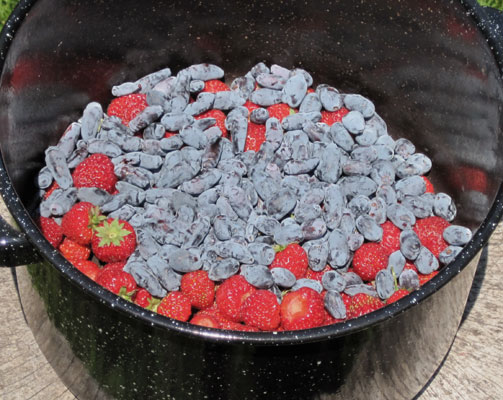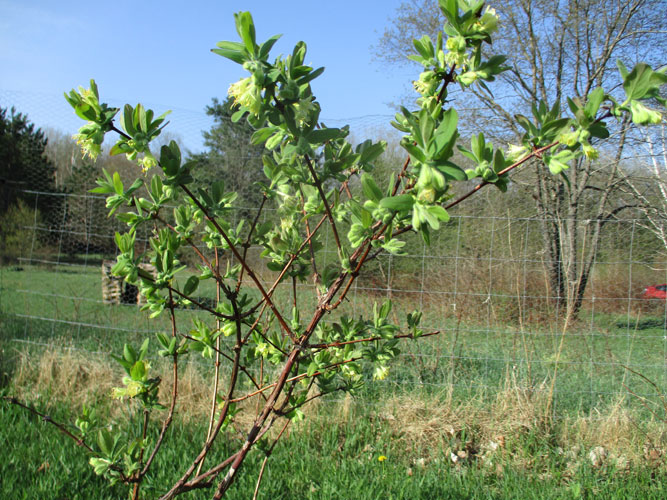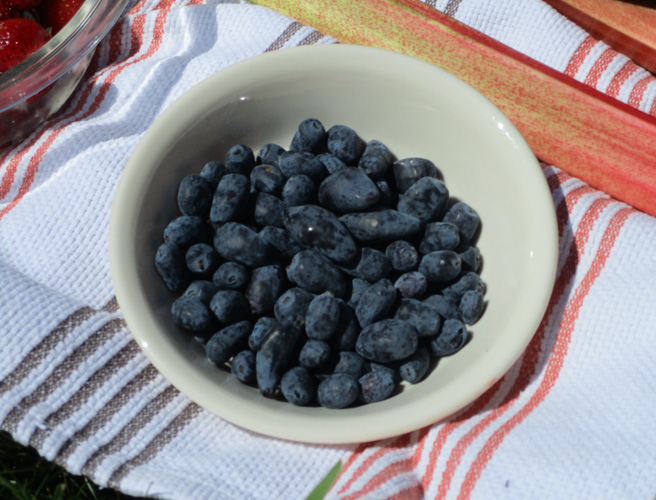|
| ||
|
Apples
Blueberries |
The ManyTracks Orchard
Haskap / Honeyberry
New, Interesting, Tasty
|
Aurora BerryBlue BlueMoon B.Beast B.Beauty B.Blizzard HoneyBee Indigo Gem
|
|
I started hearing about honeyberries or haskaps, Lonicera caerulea, several years ago. Folks on the GrowingFruit.org forum, many of whom love being on the leading edge of fruit growing, were asking, "Are you growing any? Have you seen any? Anybody tasted the berries? What are they really like? How do they grow?". This "new" fruit was starting to make its way into the USA and gaining interest, especially from those in the colder zones, but they certainly weren't common here. The new varieties had been available and grown in Canada for some years thanks to the big breeding program at the University of Saskatshewan, plus the fruit has been used in Japan for hundreds of year which also has a big presence in breeding. Haskap is a Japanese word and is the term the Univ. Sask. recommends over honeyberry (a US marketing name). There are wild haskaps in Canada and other places around the world so it is not an unknown fruit, it just hasn't been a familiar one to much of the public. The first varieties released and sold didn't do the haskap reputation any favors. Nurseries often promoted them as "like blueberries" which they aren't, except that both are blue. The name honeyberry didn't help as haskaps are not sweet, they are on the tart side, though less so with the more recent introductions. I'd say more of a raspberry/strawberry flavor. But haskaps are wonderful in their own right. They are hardy, a great fruit for the north and short season areas, are interesting and tasty, are one of the first fruits to ripen in the growing season, and are a real nice addition to many a backyard orchard. And yes, the fruit is a bit odd looking. So what is a haskap? Short answer is it is an edible blue honeysuckle. For a good introduction to the fruit and a lot of information check out the University of Saskatchewan pages at https://research-groups.usask.ca/fruit/Fruit%20crops/haskap.php. HoneyberryUSA in Minnesota is also a good source. They were one of the (maybe the) first to offer and promote these new varieties in the US. They are a family nursery, generous and highly recommended. They also have a good selection of the UofS cherries and other hardy fruit - http://www.honeyberryusa.com/. I planted my first haskaps in 2017, all Univ. Sask. introductions - Aurora and Indigo Gem, plus the new Boreal Beauty and Boreal Blizzard. In 2019 HoneyBee and the just released Boreal Beast joined the group, as did small rooted cuttings of BerryBlue and BlueMoon (the latter two are Russian varieties). I tasted my first fruit on small precocious Aurora that first year! Then a few more in 2018, a handful in 2019. I liked them! A sigh of relief. They were keepers. See the rest of the story starting in 2017 below.
2022
- I decided to move small BerryBlue and BlueMoon out of the main plot to
the far east tree row. They are both early introductions and reports are that
they are quite tart, not nearly as tasty as the later varieties. Campfire Rose
had a lot of winterkill (again) so out she came. I transplanted a small live rootball with short stubs to the top perennial row of the garden. This is
warmer (relatively) and more protected spot. Maybe she will like it better. [She
grew nicely and though relatively small put out a good array of pretty blooms.].
May 14 - Blossom time! Indigo Gem and Aurora in full swing, and late variety Beast even has started. Beauty and Blizzard began two days later. I was surprised at the close overlap of the varieties, all having flowers at various stages for several weeks. Even small BerryBlue and BlueMoon had a few (which I nipped out since they are too small to fruit). I'm so thankful that these bushes and blooms are very hardy so even if it should frost (which, not surprising, it did, two nights each the following two weeks) we're fairly assured of a good fruit year. It probably would be worth it to cover them this year to keep the birds from harvesting most. But it also would be a hassle so I haven't done it yet. My hope is to have enough fruit for all. Continue to work toward taller single "trunks" on all the bushes in order to cage against voles in winter. They would rather be bushes though so it's a slow process. June 24 - First good Haskap harvest! Two cups full, mostly Indigo and Aurora, plus quite a few Blizzard and Beauty. Taste-wise could hang longer but some are dropping and birds are enjoying them, too. More ripening on bushes. Old North Sea strawberries are also ripe so some good mixed sauce. I waffle back and forth about covering. HoneyBee - Winter hardware cage only 10"^ to fit under bottom branch. Vole ate more than half around stem right above cage. Cut down to two good buds at base. Two shoots grew. I decided to take one off to give all the energy into one strong stem. Later high wind event broke that one off. Grrrrr... No more sign of growth but I left the little stem with hope there is life in the roots and another sucker/shoot will grow. IndigoGem and Aurora- Mid May bushes full of open blossoms. Mid June nice first harvest about 1 cup each. Bushes look good. A low shoot grew on Aurora, cut Oct. 24, plant pieces in 50/50 potting soil/DE. 2wks in house then into greenhouse for winter. Four pieces - two 2-buds (bottom, largest buds), and two 3-bud (top). Hope one roots to plant between HB and IG where rose was. Beauty - Light crop, same timing as above. Blizzard - Not many branches but looking good. Light crop, same timing as others. Beast - Good but low growing. Need to get taller stem so can cage against voles. Later fruiting than Beauty and Blizzard.
2020 - We were involved in major house repair/renovation work this summer so the orchard in general and the Haskaps in particular got minimal attention, which didn't seem to bother them at all. All plants grew well, recovering from previous vole and heavy snow damage. There was fruit which mostly got left to the critters. Maybe next year I'll cover with a cage early and harvest the fruit myself! Meantime, I'm quite thankful this is a pretty hardy independent fruit. 2019 - Well, the plants were certainly protected through the winter with snow! Well buried in the three feet of white, all the bushes made it into spring in good shape. Thankfully the vole population had plummeted. Nature knows how to balance things. A barred owl had moved into the nearby woods last season and stayed all winter making good use of the plentiful hunting in the orchard, to my great appreciation and delight (our LilliBulero cat was not so happy about the new company - she has avoided the orchard since, understandably). I found numerous weasel scats all summer, and we have fox and coyote and occasional wolf. We'll always have voles and mice, at least I hope so, but a reasonable (to me) number is appreciated. I added two new plants this year - the well awaited new Boreal Beast and a HoneyBee, both University of Saskatchewan varieties. They settled in well. That is all that will fit into the blueberry cage, if I ever use it. It may not be necessary once the plants are fruiting well. Hopefully there will be plenty enough to go around. I also had cuttings of two Russian varieties - BlueMoon and BerryBlue - that someone had sent to me. They rooted well in the greenhouse late winter and in the spring I transplanted several into the nursery row in the garden. In the fall I decided to move them so added one of each to the either end of the haskap row, and to either side of a Dwarf Bush Copper honeysuckle north of the garden. It's not that these are prime varieties but having grown them from cuttings it was hard to throw any away. Campfire Rose is fitting in well with its haskap neighbors and seems to like the new location. It adds some wonderful color and interest to the lineup. I added various herbs and perennials between the young haskaps to fill out the space until the bushes are full size. The main bushes all grew well and healthy. There was fruit in small quantities, enough to snack on and add some to fresh sauce. Someone(s), maybe chipmunk, maybe bird, did feast on a fair number of the haskaps, leaving an obvious mess (and a ripped open juicy haskap fruit is a very dark purpleblue "mess"!). That was OK, they didn't eat many so I was happy to share. I ate some too early (rather sour), some too late (a bit blah), some just right (mmmm). To be honest I didn't pay much attention to the haskaps, being mostly involved elsewhere, except to pull grass, add mulch and look forward to when the bushes are large enough to hold their own in the nearby vegetation. And to appreciate these healthy plants that don't need me to fuss over them. 2018 - It was a rough winter for the haskaps, and any other plant that wasn't well protected with a surround of hardware cloth. The vole population had exploded and it was a sight to behold when the snow melted, with runs in the grass everywhere. We'd never seen anything like it. Thankfully they had plenty of brambles and young wild black cherry shoots to eat (which they did in great numbers). I think this helped save some of my plants. Aurora and Indigo Gem took a big hit. Indigo Gem had one branch left, Aurora only buds at the base. But they both recovered and grew well. Many rolls of hardware cloth was purchased and many hours spent in the fall making sure everything that could sport a cage did! Surprisingly, young small Beauty and Blizzard were spared and not only grew vigorously, both making close to 2 feet, but even produced a few fruits! While not a big taste test I can tell that these two are living up to their reported better flavor and sweetness for fresh eating. Bob Bors and the University of Saskatchewan have been quite honest about their releases, growing habits and fruit taste, and I think they are quite justified in their excitement about these newer varieties. Aurora, which being an earlier release so much more widely planted, is still holding on to good reports of its fruit. And while the others may not be as sweet they might even be preferred for processing. Sweet isn't the only important attribute. And all varieties contribute to the all important pollination picture, the haskaps needing cross pollination. I have room for two or three more plants. UofS's new Boreal Beast should be available next year. Have to get that one. Then there is the Japanese Solo and Maxie from Dr. Thompson's extensive breeding progem which get good reviews. Or maybe one of the older varieties, maybe a Russian one for diversity. I'll have a fun time this winter researching, imagining and planning. I doubt that I will have need for more fruit once the current plants get into full production, but that hardly matters. I have the space so why not fill out that section? Why not indeed. 2017 - Last fall I chose the spot for the new haskap bed, inside along the south fence between the lilac patch and the main gate. It's the lowest area of the garden/orchard but near the woods so somewhat protected, though haskaps are reliably hardy even to zone 2 so that wasn't much of a concern (a rarity in the orchard!). It was just a convenient spot for them. Cardboard and mulch was laid out, plant spots were laid out 4 feet apart, dug and loosened, all ready for spring. The future length of the bed determined by the size of the blueberry cage which I plan to do double duty when the haskaps start fruiting. Since they are ripe well before the blueberries this should work. The little plants from HoneyberryUSA arrived in early spring and were snugged into their new spots - Aurora, Indigo Gem, Boreal Beauty and Boreal Blizzard, the last two very new releases. Blizzard didn't grow but was replaced in the fall. New releases are very small plants and all that are available until HBUSA has time to grow and propagate their own. Then larger plants are usually available, but in general I prefer the smaller starts, letting them settle in to their new homes when young. The others grew well and healthy (as did Blizzard the next year) without any fuss. I also moved 2 yr old Campfire Rose into the row, deciding it needed more sun than where it was. Plus it would show up more there and I love seeing those interesting yellow-turning-pink blooms. Hopefully it will grow up as the haskaps do and hold its own in that sea of green. Maybe the haskap bushes will give it some winter protection which it could use. In early summer our lovely small black Sasha cat passed out of our lives physically, after 18 yrs of wonderful companionship. I decided to bury her under the new Blizzard haskap (we've always buried our animal companions under a plant), across the corner from where Cali, with whom she shared the house, was buried under a nice Lemon Balm. It's pleasant to think of them when tending to those plants. |
||


